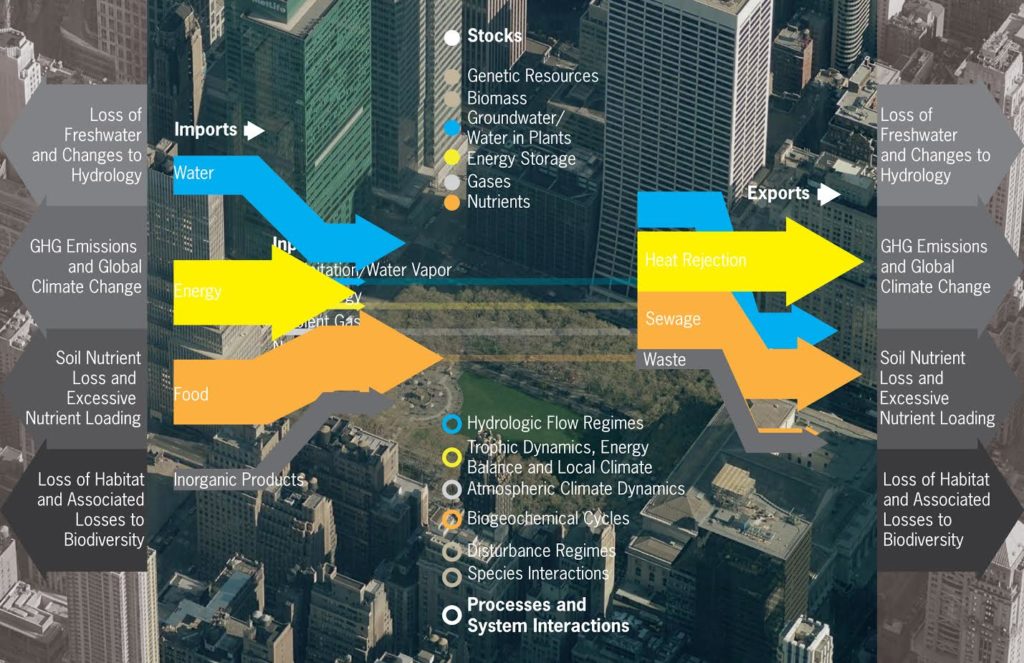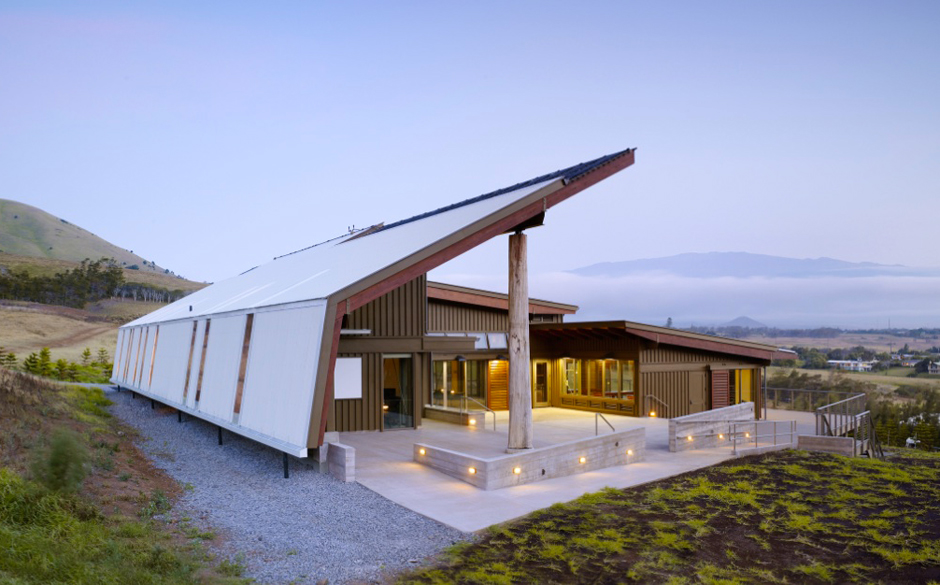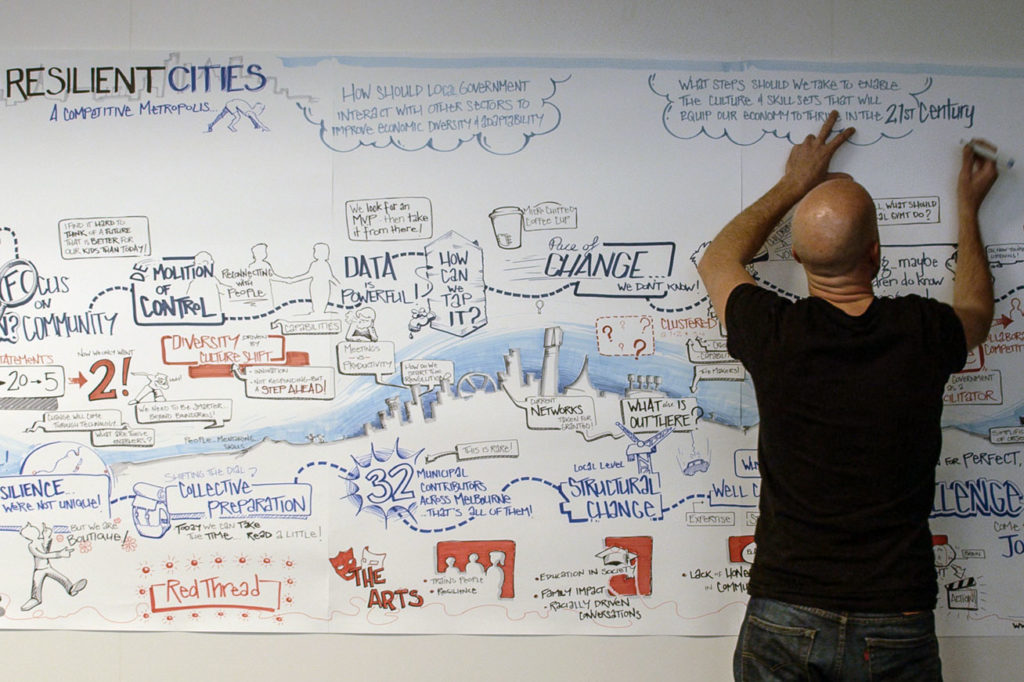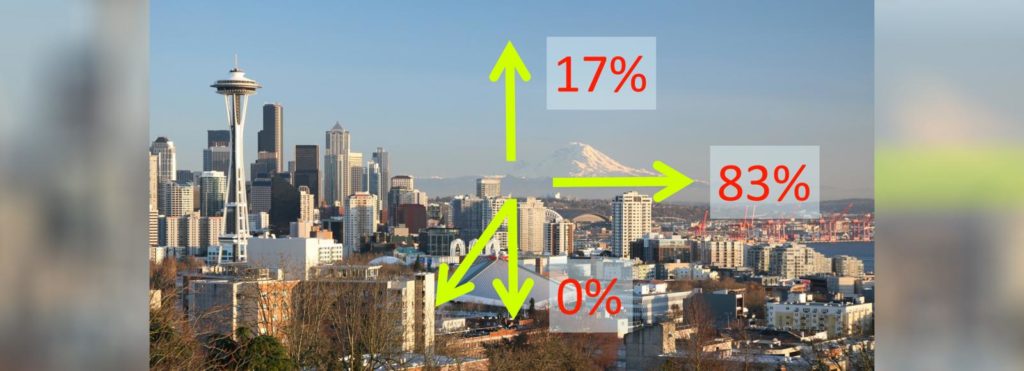By Kathy Zarsky, founder, BiomimicryTX network
Spring in Austin, Texas is the perfect time to contemplate our natural environment. All of our senses are stimulated with bursts of colors, fragrant blossoms (and seasonal allergies for some), bird song, variable weather and temperature, and longer days to soak it all in. The rhythms of life seem amplified in spring, as nature’s adornments revive our souls. For a brief while, we feel childlike abandon in our awe of nature’s beauty and processes.
Our wonder and appreciation of nature has been exceedingly dulled, if not replaced, however, with pressing societal objectives, the celebration of urban architectonic forms, our consumptive addictions, and a gradual but fundamental disconnect of humans as a part of nature. Our loss of awe and wonder stems in large part from a dismantling of the natural world in the places we inhabit. The very qualities of place that led to our first settlements have been substituted with designs for human comfort and operational efficiency. We are a unique species in that we have become the top generalist, able to make use of virtually all the components found in Earth’s ecosystems. As a result, we are less dependent on biodiversity, using our knowledge to substitute the services of one species for those of another while using technology to attempt greater control over our environments.
Whether we can all agree that we have become estranged from nature or not, we can all sense and even measure the detrimental results of many of our design decisions on our health and well-being, the quality of our air and water, resource depletion, and disaster preparedness among other things.
At a time when what we need most is hope, cities must rethink designs and decision-making to create conditions conducive to all of life by looking to nature as model, mentor and measure (Janine Benyus). Nature’s role and our connection to it are explored in five broad areas. What does it mean for Austin and cities across the globe to be resilient, regenerative, livable, just and inspiring? These brief seeds of ideas are intended to generate discourse, give hope to the individual and to organizations, and to draw constructive feedback.
Wilderness is the raw material out of which man has hammered the artifact known as civilization…the shallow-minded modern who has lost his rootage to the land assumes that he has already discovered what is important.
~Professor Aldo Leopold, 1948
RESILIENT
Nature deals with change through robust interactions that can be leveraged to maintain and rebound critical functions that are unique to place. The degree of complexity and diversity within ecosystems varies based upon the regulating pressures found there. For any given place, there are a multitude of ecological services at work, including cleansing air and water, providing edible and otherwise useful biomass, self-replicating behaviors, producing raw materials, regulating pests and diseases, and so forth. While these free services can vary year to year, compelling people throughout history to try to control them, the inherent redundancy and ability to reorganize in nature is worth emulating. The ecological system does not have to return to its original state in order to be resilient. The most important factor of note is the system’s ability to perform its core function with comparable form and behavior patterns intact. People have often thought of change as impending loss, but what nature has taught us is that change and disturbance can be the mechanisms for new possibilities.
The level of risk that organizations and communities face is growing in the face of climate change, population growth, biodiversity loss and resource scarcity. Our ability to accurately identify looming threats is limited, but that doesn’t mean that we can’t reduce risk and uncertainty while still maintaining critical functioning.
So what are nature’s resilient mechanisms and how can we apply them in Austin? At the core of ecological resiliency is its ability to have multiple stable states. If designers and decision makers can create the conditions conducive to multiple successful states rather than reductionist planning that identifies the “best” plan, chances are the right strategies will emerge. Some of the mechanisms important to transformative capacity include:
- Feedback loops: using past experience to inform future decisions, saving material, time, and energy
- Decoupling: reducing system failure caused by component level failure
- Modularity and simplicity: using like parts, progressively building from simplicity to complexity
- Variation, redundancy, and decentralization: incorporating a variety of duplicate forms, processes or systems that are not located exclusively together
- Diversity: using multiple forms, processes or systems to meet a functional need
- Reshuffle information & embrace the unexpected: exchange and alter information to create new options; incorporate mistakes that can lead to new forms/functions
There is a movement growing to start to develop more resilient cities, powered largely by the Rockefeller Foundation’s 100 Resilient Cities Challenge. This collaboration will be developing a framework and outreach based on nature’s resilience strategies. The 100RC is dedicated to helping cities around the world become more resilient to the physical, social and economic challenges that are a growing part of the 21st century.
REGENERATIVE
Regenerative cities maintain mutually beneficial relationships with their immediate and surrounding environments. This means that they go beyond trying to minimize environmental impact, and instead, strive to improve and regenerate the productive capacity of the ecosystems from which they depend.
Imagine early settlements with concentric rings depicting inputs and outputs required to sustain their inhabitants. The rings, for the most part, overlap at the boundary of the settlement, as these places are totally dependent upon local resources and the necessity of managing outputs locally. As time, growth, and innovation march forward, however, inputs begin to be sourced from farther away and outputs, whether intended or not, begin to disperse across greater distances as well. The radii of concentric rings now travel up and out to such great distances that they intersect with rings in other countries, far surpassing local sourcing and sinking capacities. The carrying capacity of local environments is no longer a limiting factor to growth, and the unseen and unsensed disbursements have led to blind spots in how we plan and design cities with rather ubiquitous qualities and patterns today.

Phoebe Framework, by Terrapin Bright Green
Now let’s imagine that cities are expressions of energy. The shape of energy in nature must also contend with boundaries and adjacencies. The shape, arrangement, and texture of natural organisms are just some of the energy expressions we can observe. Tree leaves, for example, are typically uniformly flat, to intercept as much light as possible, and spaced far from one another to prevent shading. Other organisms, like moss, are more concerned with water than light, so their leaves have evolved entirely differently. Moss leaf shapes make homes for water, as they lack roots and internal structure to transport it. The shape and texture of their outer surfaces alone move water.
Nature offers a treasure trove of strategies that can help us reduce our impact on the ecosystems that we forgot we depend upon, but more importantly, these strategies can restore our symbiotic relationship with them.
- Nature reminds us how to design for function by applying the context of operation, behavior and role for each organism and challenge faced.
- Nature uses anatomy, configuration and composition to derive structure.
- Permeability in nature allows system movement, porosity and penetration.
- Nature manages pressures with flexibility, creating malleable, bendable or pliable forms and surfaces.
- Nature uses interstitial spaces likes voids, hollows and nothingness to its advantage.
- Nature uses surfaces to mediate the energies and climates of a site.
- Energy’s shape is characterized by feedbacks, fluctuating external variables, and hence fluctuating boundaries and shapes, dynamism and succession.
- Nature uses patterns and gradients to optimize interactions and benefits.
LIVABLE
One of the best ways to foster a sense of hope is to simply create experiences that restore our vital bond with nature. Harvard biologist E.O. Wilson proposed the definition of biophilia that says, “we must acknowledge and design for the, “innately emotional affiliation of human beings to other living organisms,” which includes systems. Certain aspects of nature are culturally universal. We have cognitive and behavioral reactions to nature that ensure self-preservation, so surely the way that nature is experienced in cities can and should be linked to our well-being.
There is mounting research on the benefits of nature to human health (see resources section). The scale and range of our natural world’s design strategies and frameworks is also growing. It is important to point out that the nature-health component of livable cities is a human-centric model that can seem to describe nature as an amenity solely for our benefit. “Livable” is the descriptor used for this category rather than biophilia, because it is encouraged to be understood in context with the other nature-integration categories. Nature, at times and in limited applications, may be nothing more than window dressing for the sake of health benefit or productivity, but the aspiration should be to think of the multi-faceted benefits of healthy natural ecosystems integrated within cities. Biophilic design, on the other hand, is a means of creating livable cities that addresses our innate affinity for nature, the natural world’s inherent beauty of form-process-pattern. It simultaneously provokes inquiry about ‘why-where-how’ in nature.
It is important, therefore, that we support Austin’s aspirations as a Biophilic City and encourage other cities to follow suit, meaning the scale of ecological integration is for the benefit of all inhabitants. Biophilic cities recognize the implication of regeneration, and thus act in accordance to known impacts of resource use on nature and biodiversity beyond their urban borders. One of the easiest to digest and implement frameworks for biomimicry is Terrapin Bright Green’s 14 Patterns of Biophilic Design. This framework navigates three design categories: nature in the space, natural analogues, and nature of the space. Additional guidance and opportunities to receive recognition for biophilic design integration can be found in the Well Building Standard, the Living Building Challenge, and the Living Community Challenge.

The Omega Center for Sustainable Living – a Living Building
Perhaps we don’t need such rigorous evidence when it comes to nature contact…Maybe we don’t know everything there is to know about human benefits of nature contact, but we have a pretty fair idea, and we know a lot about designing nature into the built environment. And given the pace at which decisions are being made and places built, there is a pressuring need to implement what we know. We can’t wait for the research.
~Howard Frumkin, 2008, Nature Contact and Human Health, Biophilic Design
JUST
Disproportionate access to nature is something all cities need to work to address. While social equity is a very broad topic, an aerial assessment of Austin, TX, for example reveals the inequitable distribution of natural ecosystems. Views and sounds of nature, abundance of trees and vegetation, watercourses, and access to green spaces are disproportionately located to the west. Accessibility to quality ecological experiences is a remedy for any city striving to be just- for all life. Nature can be incorporated into designs intended with clear purpose, but true ecological integration leaves room for experiential interpretation, exploration, and flexibility in use. What equal access to nature allows is choice – it is a socializing environment for some, a place for exploration or meditation for others, and a haven for imaginative play often unleashed by children.
Austin should have an abundance of diverse natural systems in close proximity to its inhabitants, such as contiguous riparian buffer corridors for wildlife to come into urbanized, concretized and fragmented cities. Additionally, the opportunities to experience these places should also be diverse, such that strolling, hiking, bicycling, exploring and gathering are all available.
Because the cognitive, behavioral and health benefits of access to nature have been scientifically proven, communities and cities should take advantage of the growing number of quantifiable services provided by nature. These services should be pondered in relation to their resilient, regenerative and livable attributes, as well. While a vast expanse of monoculture lawn may appeal to one type of ecological experience, namely a sense of prospect with an unimpeded view, its lack of biodiversity and poor ‘energy shape’ make it a far less healthy landscape for long-term life.
A city that prioritizes an abundance of nature and nature experiences must also seek to educate about nature and biodiversity. Equal opportunities for everyone to learn about the richness of the places they live through schools, parks, clubs, programs and projects serves to reinforce the connection and ultimately renewed valuation of nature. Create places in neighborhoods that people want to be, with vegetation. Right now, our connection to one another is just as fragmented as our relationship to nature, but as we come together we get to know one another and build empathy.
It is not the walking merely, it is keeping yourself in tune for a walk…when the exercise of your limbs affords your pleasure, and the play of your senses upon the various objects and shows of nature quickens and stimulates your spirit, your relation to the world and yourself is what it should be – simple and direct and wholesome.
~John Burroughs in Pepacton, 1881
INSPIRING
If you’ve read the recent article, This Is How Much An Urban Forest Is Worth, a study conducted by researchers from Texas A&M Forest Service, you’ve been inspired to think differently about trees. Their research used a software tool called iTree to model ecosystem services provided by trees like air pollution removal, reduced emissions and stormwater runoff, reduced energy use for buildings, and sequestration of carbon. These are all clearly important benefits, but wouldn’t it be equally beneficial to understand more about how trees do these things? For example, trees employ a variety of branching designs that reduce wind stress. Perhaps there’s an application for our design structures that are challenged with wind stress. Trees in cloud forests comb water from the clouds. Could we devise strategies to capture water from moisture-laden gulf breezes at certain times of the year? Conversely, could we look to how tree foliage density, leaf thickness, leaf texture and color all interact to enhance the cooling effect for the tree to also cool our environments? Tree bark keeps their surface cool by minimizing absorption of solar light and maximizing thermal emission. We’re just talking trees here, and we’re only just getting started with all of their amazing strategies. The bottom line is that organisms cannot afford to decorate themselves with functionless features. Everything they do has been optimized and serves a purpose.
As we think about ways in which we can be more resilient, regenerative, livable and just as a city, turning to unexpected sources of inspiration to help us adapt and live in balance with Earth’s complex systems is both smart and hopeful. The city of Austin, for example has put innovation front and center for economic development with a focus of making Austin the #1 region to start and grow a technology and innovation based business. Most innovators are full of questions, however, and it’s hard to find a better source of inspiration, ideas, and answers than our natural world. All cities should seek to create products, processes, systems and policies- new ways of living- that are well-adapted to place and that support life over the long haul. For these reasons, Austin’s innovation agenda must align.
Nature is a showcase of success stories, with many ingenious organisms already showing us the way. Strategies maximizing adaptability to current local and global issues such as increased frequency, size and velocity of climatic events, exponential population growth, increasing demand for urban biodiversity, and growing need for food production should drive design and policy decisions. Nature’s lessons will challenge the way we currently think about design, so that we can conceive form and surfaces as gills or deposition layers, as habitat for pollinators, as imperfect and changing, but always beautiful.
It is projected that by 2050, approximately 70% of the world’s population will be living in cities, most of which consist of an urban fabric where the total area of hardscape surfaces significantly outweigh the total area of living system surfaces. Higher integration of ecological systems in urban fabric surfaces can help create adaptable building and city conditions. Nature offers us hope, by promoting human health and helping us find new ways to define, inspire, and manifest resilient and adaptable living cities.
About the Author
Kathy Zarsky is the Systems Director at HOLOS, a sustainability consultancy whose core tenet is systems thinking and collective intelligence. She is a sustainable and regenerative building advisor, process mapper, biomimicry and biophilia practitioner, educator, and speaker. As a systems and strategy designer, Kathy’s work has focused on the dynamic relationship between people and the built environment at multiple scales. Her goal is to enable solutions that lead to a greater natural ecology through exploration of design and systems using biomimicry and biophilia frameworks. She recently explored biomimicry and biophilia applications with a global technology company.
In 2011, Kathy became one of the world’s first Biomimicry Specialists, bringing unique perspective and innovative thinking to design challenges. That same year Kathy founded BiomimicryTX, one of a growing number of global network affiliates of the Biomimicry Institute. Since that time, she has led partnership efforts with SXSW Eco, organized a biomimicry design challenge focused on water with Southern Methodist University, spoken at conferences around the country, written education curricula and developed resources for camp and school programs. She will be launching a new children’s program this fall alongside supporting Austin’s Biophilic City objectives.
Photo credit: Primary image by Maury Jacks
RESOURCES AND IDEAS
100 Resilient Cities- provides resources and support to selected cities that want to develop and implement resiliency strategies
http://www.100resilientcities.org/
International Living Future Institute- serves a movement of cultivating restorative ecosystems in which thriving communities benefit the biosphere as a whole
http://living-future.org/ilfi/ideas-action
Biophlic Cities Network- supporting cities where nature is at the forefront of design and planning decisions and where people are encouraged to develop deeper connections with the nature all around them
14 Patterns of Biophilic Design- Terrapin Bright Green’s research publication
http://www.terrapinbrightgreen.com/reports/14-patterns/
BiomimicryTX- local a community of change makers promoting innovation inspired by nature
https://www.facebook.com/BiomimicryTX/
The Biomimicry Institute- empowering people to create nature-inspired solutions for a healthy planet (BiomimicryTX is one of the first regional networks)
AskNature- curated online library features free information on over 1,800 natural phenomena and hundreds of bio-inspired applications.
Families in Nature- connecting children and their families to nature and to each other through time spent learning, playing and volunteering outdoors
Austin Trail Directory
http://www.austintexas.gov/page/trail-directory
Falling Fruit- facilitates the connection between people, food and the natural organisms growing in neighborhoods.
https://fallingfruit.org/
Capital Area Master Naturalists- educating the public about the natural work in and around Austin, and providing community programs and projects that increase appreciation
The Natural Capital Plant Database- searchable by plants based on selected criteria to creating ecological analogs
http://permacultureplantdata.com/
This is How Much a Forest is Worth- article in Conservation magazine highlighting a study conducted on Austin’s urban forest.



